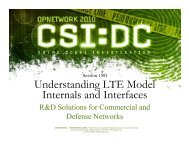Automated Axon Tracking of 3D Confocal Laser Scanning ...
Automated Axon Tracking of 3D Confocal Laser Scanning ...
Automated Axon Tracking of 3D Confocal Laser Scanning ...
You also want an ePaper? Increase the reach of your titles
YUMPU automatically turns print PDFs into web optimized ePapers that Google loves.
To avoid this problem, we introduce constraints in the algorithm that use the informationfrom the segmented regions in the previous slice. First, the radius <strong>of</strong> the kernel is determined as:R =min( r,a)2(3)where, r is the radius <strong>of</strong> a circle with the same area as the segmented region and a is the minoraxis after fitting an ellipse to the segmented region. This helps in minimizing the errors infinding the seed points when the axons have irregular shapes.The mean shift is then applied inside a window instead <strong>of</strong> the whole image. This constraintensures that the seed points do not move out <strong>of</strong> the actual axon. The size <strong>of</strong> the window is set totwice the diameter <strong>of</strong> a circle that has the same area as the segmented axon cross-section in theprevious slice. This is a reasonable assumption since the changes in axon position from one sliceto the next is known to be smooth. Figure 5 shows the trajectory <strong>of</strong> the mean-shift for an axoninside a window. The green cross indicates the starting point <strong>of</strong> the mean-shift. The trajectory <strong>of</strong>the algorithm is shown by the series <strong>of</strong> Blue crosses. The Red cross indicates the point to whichthe mean-shift converges.Figure 5 - The trajectory <strong>of</strong> the mean-shift algorithm. The scale bar in the figure corresponds to 0.2μm. Since this isa magnified version <strong>of</strong> the actual image, the pixels are seen as block-like structures.16















